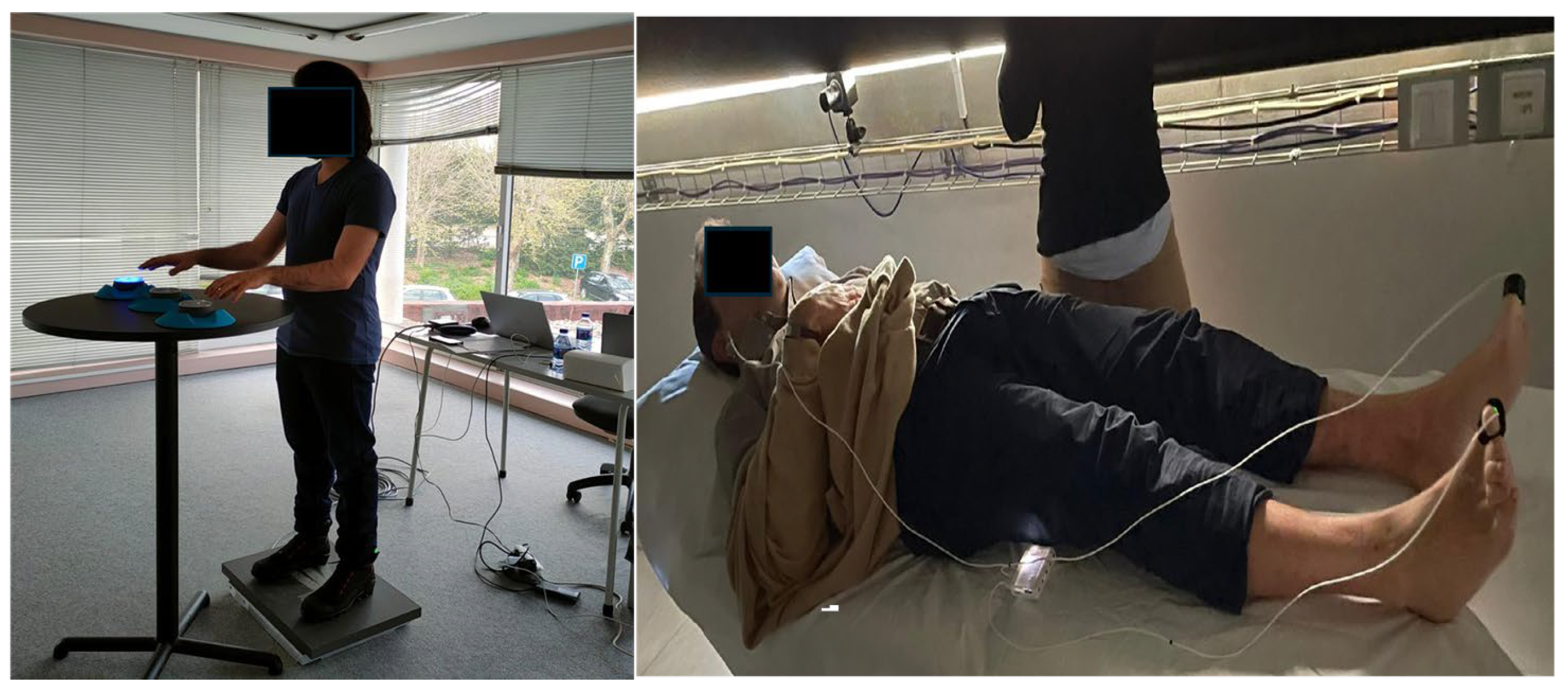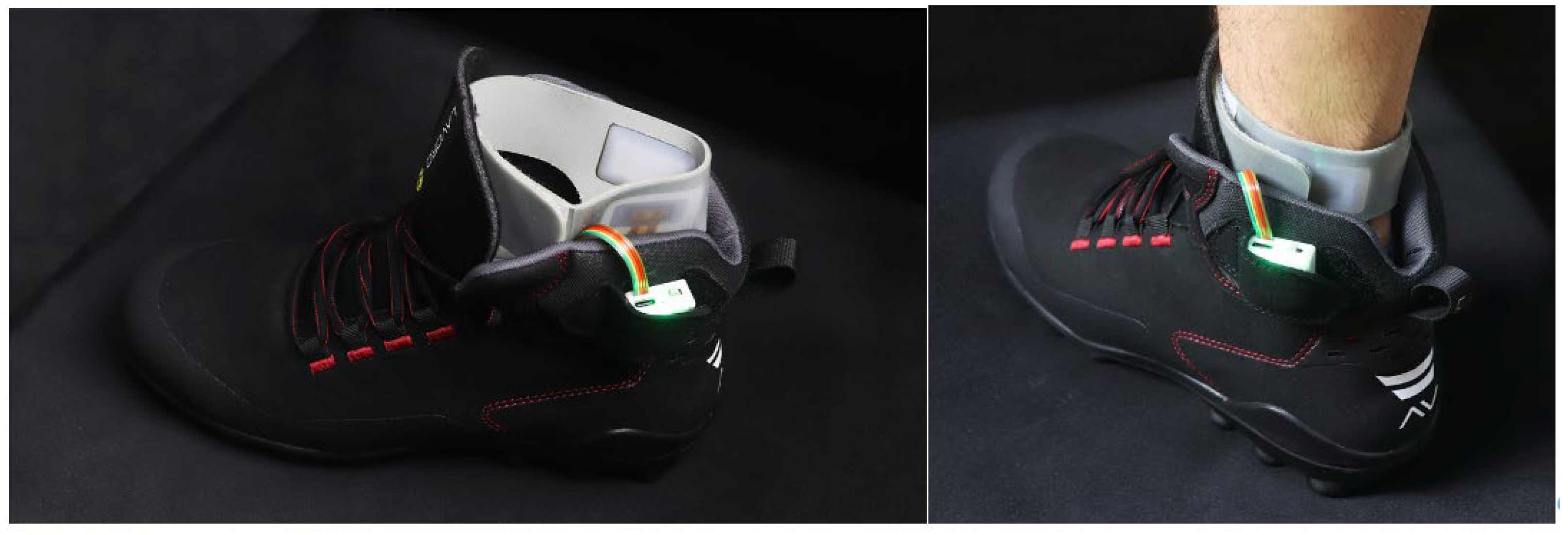Evaluating the Impact of Active Footwear Systems on Vascular Health and Static Balance: An Exploratory Study
Abstract
1. Introduction
2. Materials and Methods
2.1. Participants
2.2. Study Procedures
2.3. Outcomes
2.3.1. Reflection Photoplethysmography
2.3.2. Postural Sway
2.4. Active System
2.5. Data Analysis
3. Results
4. Discussion
4.1. Implications
4.2. Limitations
4.3. Future Directions
5. Conclusions
6. Patents
Author Contributions
Funding
Institutional Review Board Statement
Informed Consent Statement
Data Availability Statement
Conflicts of Interest
Abbreviations
| CoP | Center of pressure |
| PPG | Reflection photoplethysmography |
| WRMSDs | Work-related musculoskeletal disorders |
References
- Banks, J.J.; Umberger, B.R.; Boyer, K.A.; Caldwell, G.E. Lower back kinetic demands during induced lower limb gait asymmetries. Gait Posture 2022, 98, 101–108. [Google Scholar] [CrossRef] [PubMed]
- Jo, H.; Lim, O.; Ahn, Y.-S.; Chang, S.; Koh, S.-B. Negative Impacts of Prolonged Standing at Work on Musculoskeletal Symptoms and Physical Fatigue: The Fifth Korean Working Conditions Survey. Yonsei Med. J. 2021, 62, 510–519. [Google Scholar] [CrossRef] [PubMed]
- Pucci, C.; Dell’Omo, M.; Lesage, F.-X.; Murgia, N.; Annesi-Maesano, I. O-028 Musculoskeletal disorders as a work-related risk factor of unfitness for work: A cross-sectional study of 1,327,540 workers in occitania, FRANCE. Occup. Med. 2024, 74 (Suppl. S1), i183–i184. [Google Scholar] [CrossRef]
- Segalo, S.; Pasalic, A.; Macak-Hadziomerovic, A.; Maestro, D.; Pecar, M.; Katana, B. Association Between Risk Factors and Prevalence of Musculoskeletal Disorders Among Laboratory Professionals—An European Perspective. Mater. Socio-Med. 2023, 35, 101–107. [Google Scholar] [CrossRef] [PubMed]
- Espeit, L.; Lapole, T. Effects of graduated compression stockings, local vibration and their combination on popliteal venous blood velocity. Phlebology 2020, 35, 505–512. [Google Scholar] [CrossRef] [PubMed]
- Lurie, F.; Schwartz, M. Patient-centered outcomes of a dual action pneumatic compression device in comparison to compression stockings for patients with chronic venous disease. J. Vasc. Surg. Venous Lymphat. Disord. 2017, 5, 699–706.e1. [Google Scholar] [CrossRef] [PubMed]
- Griffin, M.; Bond, D.; Nicolaides, A. Measurement of blood flow in the deep veins of the lower limb using the gekoTM neuromuscular electro-stimulation device. Int. Angiol. A J. Int. Union Angiol. 2016, 35, 406–410. [Google Scholar]
- Ren, W.; Pu, F.; Luan, H.; Duan, Y.; Su, H.; Fan, Y.; Jan, Y.-K. Effects of Local Vibration with Different Intermittent Durations on Skin Blood Flow Responses in Diabetic People. Front. Bioeng. Biotechnol. 2019, 7, 310. [Google Scholar] [CrossRef] [PubMed]
- Rodrigues, L.M.; Nuno, S.L.; Granja, T.; Florindo, M.E.; Gregório, J.; Atalaia, T. Perfusion, Stance and Plantar Pressure Asymmetries on the Human Foot in the Absence of Disease—A Pilot Study. Symmetry 2022, 14, 441. [Google Scholar] [CrossRef]
- Allen, J.; Overbeck, K.; Stansby, G.; Murray, A. Photoplethysmography assessments in cardiovascular disease. Meas. Control. 2006, 39, 80–83. [Google Scholar] [CrossRef]
- Lopes, M.; Lopes, S.; Monteiro, M.; Rodrigues, M.; Fertuzinhos, A.; Coelho, A.d.S.; Matos, P.; Borges, A.; Leite, T.; Sampaio, C.; et al. Exploring the Efficacy of a Set of Smart Devices for Postural Awareness for Workers in an Industrial Context: Protocol for a Single-Subject Experimental Design. JMIR Res. Protoc. 2023, 12, e43637. [Google Scholar] [CrossRef] [PubMed]
- Karimi, Z.; Valipour, F. The Effectiveness of Active Insoles in Reducing the Impacts of Fatigue on Standing Stability and Balance Among Military Forces: A Biomechanical Evaluation. J. Health Saf. Work. 2023, 13, 797–816. [Google Scholar]
- Sader, M.A.; Celermajer, D.S. Endothelial function, vascular reactivity and gender differences in the cardiovascular system. Cardiovasc. Res. 2002, 53, 597–604. [Google Scholar] [CrossRef] [PubMed]
- Krejčí, M.; Kajzar, J.; Psotta, R.; Tichý, M.; Kancheva, R.; Hošek, V.; Hill, M. Are There Sex Differences in Balance Performance after a Short-Term Physical Intervention in Seniors 65+? A Randomized Controlled Trial. Appl. Sci. 2022, 12, 3452. [Google Scholar] [CrossRef]
- Orlando, G.; Brown, S.; Jude, E.; Bowling, F.L.; Boulton, A.J.; Reeves, N.D. Acute Effects of Vibrating Insoles on Dynamic Balance and Gait Quality in Individuals with Diabetic Peripheral Neuropathy: A Randomized Crossover Study. Diabetes Care 2024, 47, 1004–1011. [Google Scholar] [CrossRef] [PubMed]



| Male (n = 7) | Female (n = 9) | |||
|---|---|---|---|---|
| Difference | p-Value | Difference | p-Value | |
| Active phase | ||||
| Maximum | −44.9 ± 116.1 | 0.171 | 14.4 ± 153.2 | 0.695 |
| Median | 4.5 ± 13.8 | 0.031 | −2.4 ± 22.4 | 0.654 |
| Root Mean Square | −2.1 ± 6.5 | 0.167 | 3.3 ± 10.3 | 0.187 |
| Placebo phase | ||||
| Maximum | −7.0 ±183.6 | 0.889 | −60.2 ± 139.5 | 0.085 |
| Median | −1.9 ± 23.7 | 0.770 | 1.9 ± 23.1 | 0.729 |
| Root Mean Square | 1.1 ± 11.7 | 0.728 | −1.8 ± 10.9 | 0.500 |
| Male (n = 7) | Female (n = 9) | |||
|---|---|---|---|---|
| Difference | p-Value | Difference | p-Value | |
| Active phase | ||||
| Total CoP 1 displacement (mm) | 0.016 ± 0.039 | 0.351 | −0.015 ± 0.016 | 0.025 |
| CoP 1 velocity (mm/s) | 0.003 ± 0.004 | 0.903 | −0.005 ± 0.010 | 0.179 |
| Placebo phase | ||||
| Total CoP 1 displacement (mm) | 0.014 ± 0.038 | 0.312 | −0.007 ± 0.018 | 0.273 |
| CoP 1 velocity (mm/s) | 0.000 ± 0.004 | 0.119 | 0.002 ± 0.007 | 0.393 |
Disclaimer/Publisher’s Note: The statements, opinions and data contained in all publications are solely those of the individual author(s) and contributor(s) and not of MDPI and/or the editor(s). MDPI and/or the editor(s) disclaim responsibility for any injury to people or property resulting from any ideas, methods, instructions or products referred to in the content. |
© 2025 by the authors. Licensee MDPI, Basel, Switzerland. This article is an open access article distributed under the terms and conditions of the Creative Commons Attribution (CC BY) license (https://creativecommons.org/licenses/by/4.0/).
Share and Cite
Lopes, S.; Rodrigues, M.; Lopes, M.; Costa, R.; Alvarelhão, J. Evaluating the Impact of Active Footwear Systems on Vascular Health and Static Balance: An Exploratory Study. Sensors 2025, 25, 1724. https://doi.org/10.3390/s25061724
Lopes S, Rodrigues M, Lopes M, Costa R, Alvarelhão J. Evaluating the Impact of Active Footwear Systems on Vascular Health and Static Balance: An Exploratory Study. Sensors. 2025; 25(6):1724. https://doi.org/10.3390/s25061724
Chicago/Turabian StyleLopes, Susana, Mário Rodrigues, Mário Lopes, Rui Costa, and Joaquim Alvarelhão. 2025. "Evaluating the Impact of Active Footwear Systems on Vascular Health and Static Balance: An Exploratory Study" Sensors 25, no. 6: 1724. https://doi.org/10.3390/s25061724
APA StyleLopes, S., Rodrigues, M., Lopes, M., Costa, R., & Alvarelhão, J. (2025). Evaluating the Impact of Active Footwear Systems on Vascular Health and Static Balance: An Exploratory Study. Sensors, 25(6), 1724. https://doi.org/10.3390/s25061724






